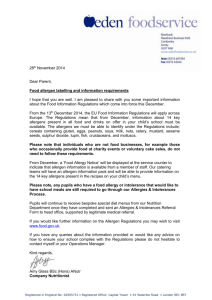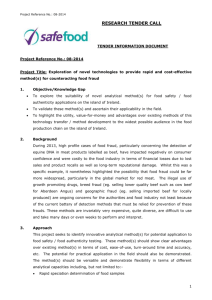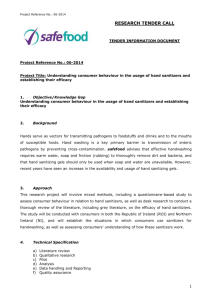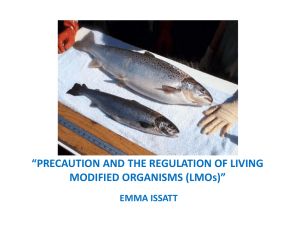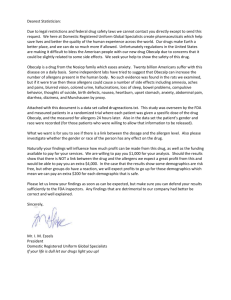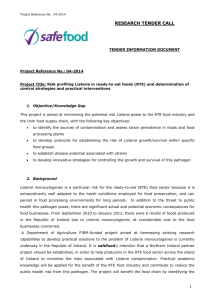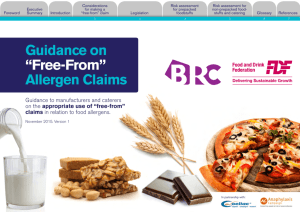Assessment of the critical control points during domestic
advertisement
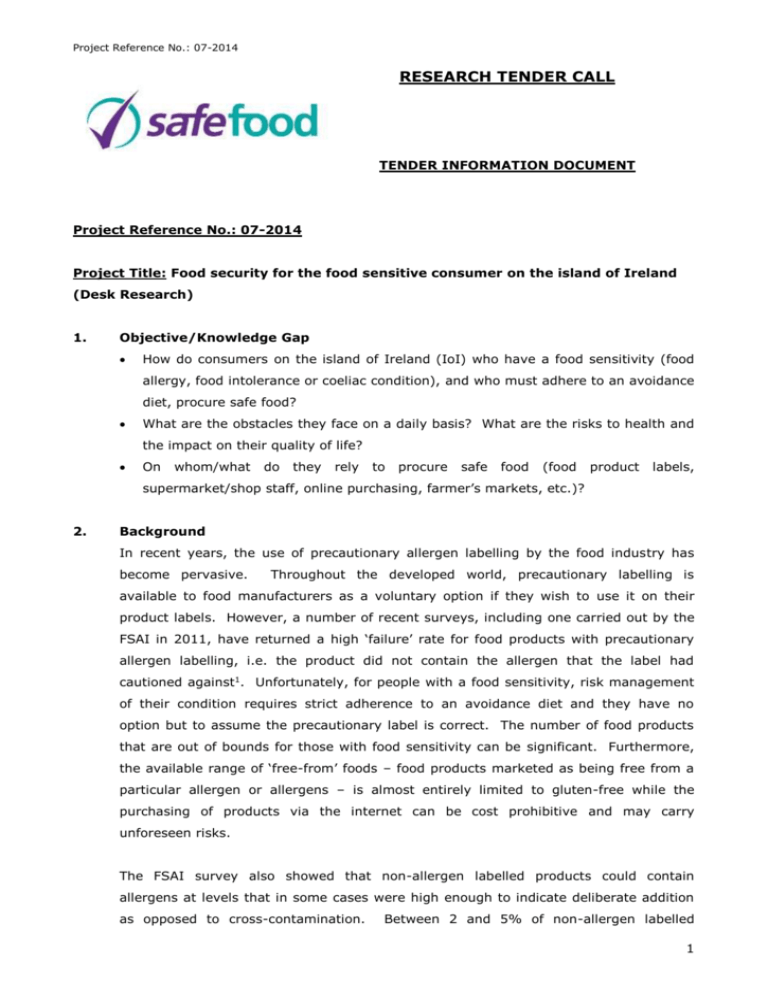
Project Reference No.: 07-2014 RESEARCH TENDER CALL TENDER INFORMATION DOCUMENT Project Reference No.: 07-2014 Project Title: Food security for the food sensitive consumer on the island of Ireland (Desk Research) 1. Objective/Knowledge Gap How do consumers on the island of Ireland (IoI) who have a food sensitivity (food allergy, food intolerance or coeliac condition), and who must adhere to an avoidance diet, procure safe food? What are the obstacles they face on a daily basis? What are the risks to health and the impact on their quality of life? On whom/what do they rely to procure safe food (food product labels, supermarket/shop staff, online purchasing, farmer’s markets, etc.)? 2. Background In recent years, the use of precautionary allergen labelling by the food industry has become pervasive. Throughout the developed world, precautionary labelling is available to food manufacturers as a voluntary option if they wish to use it on their product labels. However, a number of recent surveys, including one carried out by the FSAI in 2011, have returned a high ‘failure’ rate for food products with precautionary allergen labelling, i.e. the product did not contain the allergen that the label had cautioned against1. Unfortunately, for people with a food sensitivity, risk management of their condition requires strict adherence to an avoidance diet and they have no option but to assume the precautionary label is correct. The number of food products that are out of bounds for those with food sensitivity can be significant. Furthermore, the available range of ‘free-from’ foods – food products marketed as being free from a particular allergen or allergens – is almost entirely limited to gluten-free while the purchasing of products via the internet can be cost prohibitive and may carry unforeseen risks. The FSAI survey also showed that non-allergen labelled products could contain allergens at levels that in some cases were high enough to indicate deliberate addition as opposed to cross-contamination. Between 2 and 5% of non-allergen labelled 1 Project Reference No.: 07-2014 products were found to contain peanut, egg and/or soya allergen. This may seem small but it quantifies to some degree the risk for people with these allergies; a chance encounter may have a serious outcome. 3. Approach The safefood research will collate information on allergen labelling practices and the production of focussed food products plus current options available for the food sensitive consumer to acquire safe and suitable food products. The interplay between these factors and how they influence the overall food security of the food sensitive population on the IoI will be clarified. The research will set out to answer a number of questions including:1. What analysis of the IoI market for free-from foods (peanut- and tree nut-free, eggfree, dairy-free, etc.) has been carried out? 2. What is the extent of pre-packed free-from food production on the IoI? Are there data available for similar products imported and/or ordered online? 3. Has the export potential for free-from foods produced on the IoI been determined? 4. What are the key factors that trigger food manufacturers to apply precautionary labelling to a food product? 5. Which food industry sectors are forthcoming with allergen information (including via their websites)? 6. What are the costs for testing for food allergens in food matrices and where is this carried out on the IoI? 7. Are the current precautionary statements, which have not been defined at regulatory level, fit for purpose? Can this information be expanded to give the allergen status of the factory as well as the product? 8. Do we have examples of precautionary labelling that works? i.e. that gives balanced logical information to the allergic customer to enable them to make an informed choice while at the same time augmenting the due diligence defence of the food manufacturer. 9. In the context of the objective / knowledge gap, what are the experiences of food sensitive consumers in other countries and are there any learnings therein that would benefit their counterparts on the IoI? 4. Technical Specification a) Final report. The final report will detail the challenges faced by the food sensitive consumer on the IoI in procuring safe food in the context of an avoidance diet. It will make recommendations as to how best the risks to consumer health and impacts on their quality of life can be addressed and will also highlight any knowledge gaps that could benefit from further focussed research. 2 Project Reference No.: 07-2014 b) Data Handling and Reporting. 1. The contractor is responsible for collating all outcomes and a final report will be submitted to safefood on completion of the study. This will include recommendations for possible further developments including IoI-specific research gaps. 2. All forms, documentation and electronic files must be retained by the contractor until further notice from safefood in case of issues arising after the completion of the research. c) Quality Assurance. 1. The report must specify the sources of information, whether peer-reviewed publications, expert consultations and correspondence, official policy material, etc. 2. safefood may convene a meeting with the contractors during the course of the research to assess progress. 5. Evaluation of Tenders Tender bids will be evaluated according to the quality of proposals and applicants using the following criteria: Quality of the proposal: Anticipated deliverables; Research method; Value for money; Potential for application; Work plan, including the overall timeframe. Quality of Applicants: 6. Experience in subject area; Existing capacity to execute the project; Quality Assurance and Quality Control measures in place. Duration of Project Estimated duration of the project: desk-based research for a period not exceeding 8 months. 3 Project Reference No.: 07-2014 7. Scientific Aspects Potential applicants are encouraged to contact the Research Administration Office at safefood for further information about this research project. 8. Tender Application Forms and Guidelines The Tender Application Form and associated Guidelines can be downloaded from www.safefood.eu. They can also be obtained by emailing research@safefood.eu, quoting the project reference number 07-2014. Alternatively please contact safefood as per the details below. Ms Gillian Fox/Ms. Veronica Sheehan Research Coordinator Research Office safefood 7 Eastgate Avenue Little Island Co. Cork Tel: +353 21-2304100 Fax: +353 21-2304111 1 Food Safety Authority of Ireland. Monitoring & Surveillance Series: Food Allergens & Labelling Survey. June 2011. Retrieved at www.fsai.ie/ 4
